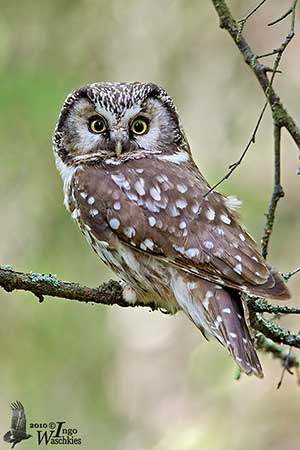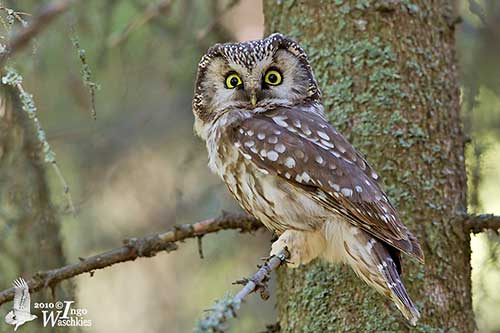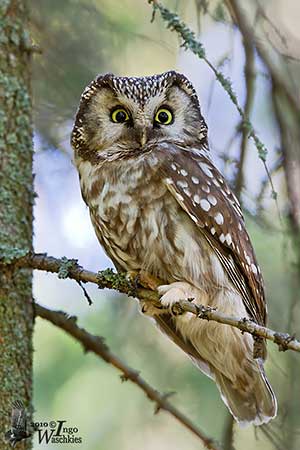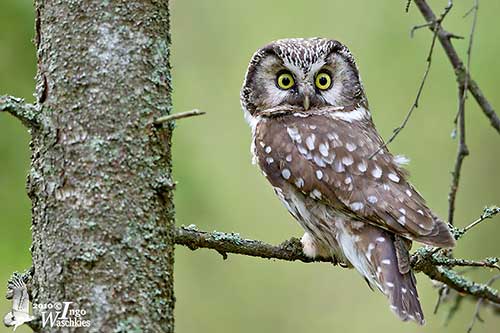
Fr: Nyctale de Tengmalm
Ang: Boreal Owl – Tengmalm’s Owl
All: Raufußkauz
Esp: Mochuelo Boreal
Ita: Civetta capogrosso
Nd: Ruigpootuil
Sd: Pärluggla
Photographers:
Ingo Waschkies
My bird pictures on Pbase
Text by Nicole Bouglouan
Sources:
HANDBOOK OF THE BIRDS OF THE WORLD Vol 5 by Josep del Hoyo-Andrew Elliott-Jordi Sargatal - Lynx Edicions - ISBN: 8487334253
THE HANDBOOK OF BIRD IDENTIFICATION FOR EUROPE AND THE WESTERN PALEARCTIC by Mark Beaman, Steve Madge - C. Helm - ISBN: 0713639601
BIRDS OF THE MIDDLE EAST by R.F. Porter, S. Christensen, P Schiermacker-Ansen C.Helm - ISBN: 0713670169
All About Birds (Cornell Lab of Ornithology)
Bird Web (Seattle Audubon Society)
What Bird-The ultimate Bird Guide (Mitchell Waite)
Wikipedia, the free encyclopaedia
Owling.com - The largest US website totally dedicated to owls
Boreal Owl or Tengmalm’s Owl
Aegolius funereus
Strigiformes Order – Strigidae Family
INTRODUCTION:
The Boreal Owl is included in the saw-whet group, genus Aegolius. These owls are small, short-tailed and tuftless, and live in woodlands. This species is found both in Nearctic and Palearctic regions (Holarctic).
This shy owl hunts by night and roosts by day, usually well-camouflaged in dense vegetal cover.
The Boreal Owl is not globally threatened, but its populations are closely related to prey abundance.
It is named Boreal Owl in North America, named after the Greek god Boreas. It is known as Tengmalm’s Owl in the Old World, and this name pays tribute to the Swedish naturalist Peter Gustaf Tengmalm.

DESCRIPTION OF THE BIRD:
Biometrics:
Length: M: 21-25 cm – F: 25-28 cm
Weight: M: 90-115 g – F: 120-195 g
The Boreal Owl adult has dark brown upperparts with conspicuous white spotting on scapulars, and smaller white spots on back and rump. On the upperwing, the primaries show five rows of white spots. The short tail is brown with 4-5 white bars.
The underparts are creamy-white with brown to russet streaks, usually heavier on the breast.
On the head, the crown is brown, heavily and finely spotted white. We can see a conspicuous whitish facial disk, surrounded by dark rim with small white spots, and highlighted by white, raised eyebrows. This owl has a large head compared to the body size.
The Boreal Owl is known for its asymmetrical ear-openings. The right ear is up to 50% larger than the left one and directed upwards, whereas the left ear is directed downwards.
The small, hooked bill is yellow to horn. The eyes are yellow. Legs and feet are thickly feathered white with dark claws.
Male and female have similar plumage, but the female is larger than male.
The juvenile has chocolate-brown upperparts and brown underparts. The facial disk is brown with black border.
SUBSPECIES AND RANGE:
The Boreal Owl has 6 subspecies, sometimes 7 when some authors separate the race “sibiricus” of C Siberia to Sakhalin and NE China, from the race “pallens”.
The races differ mainly in plumage colour.
A.f. funereus is found in Europe, from N Scandinavia S to Pyrenees, and then E to Urals, but excluding Caucasus.
A.f. caucasicus is found in Caucasus.
A.f. pallens is found in W Siberia to Tien Shan, and S Siberia and N Mongolia, E through NE China to Russian Far East, including Sakhalin.
A.f. magnus occurs in N Siberia, from Kolyma to Kamchatka.
A.f. beickianus is found in NW India and NC China.
A.f. richardsoni is found in North America, from C Alaska S in Rocky Mountains to W USA, and E through Canada to Labrador.
Among the Eurasian races, A.f. magnus is largest and brightest. In North America, A.f. richardsoni is the darkest.
HABITAT:
The Boreal Owl breeds mainly in mixed-species forests with conifers (spruce or fir) and deciduous trees (aspen or birch), usually boreal and subalpine forests.
During winter, it is mostly found in mature forest with easy access to preys thanks to unfrosted snow. Later, it can be seen hunting in more open areas including cultivated fields and openings and forest edges.
CALLS AND SONGS: SOUNDS BY XENO-CANTO
During the breeding season, the Boreal Owl male gives territorial calls, a series of fast, deep, far-carrying whistling hoots “po po po po po po …” repeated at intervals of a few seconds and during long periods. It also gives a nasal “kuwake” and a short, smacking “chiak”.
The female gives aggressive “kwahk” and may produce a mewing call. The young begging for food utter short, explosive “psee”.
BEHAVIOUR IN THE WILD:
Like most Strigidae, the Boreal Owl feeds on a variety of vertebrates and invertebrates such as small rodents including shrews, several vole species, lemmings, mice and moles. But it also takes birds such as chaffinches and thrushes, bats, squirrels, frogs and beetles.


The Boreal Owl hunts from perch, usually low branch or tree trunk. Thanks to its directional hearing, it listens attentively for movements of small animal and moves slowly its head from side to side, in order to scan the ground. Once the prey is detected and located, its swoops onto its victim and catches it with the talons. It is a nocturnal hunter and is able to detect preys under the snow. Later, it rejects thick, grey pellets from its daytime roost.
Prior to the breeding season, the Boreal Owl male searches for nesting holes in late winter. It often deposits a prey into the hole before to sing to attract a female. If a female approaches, the male reaches the cavity and sings again. The female usually inspects the hole and they stay there if she accepts. The male performs courtship feeding to the female while she is inside the cavity.
The mating system may vary according to food resources. This species can be monogamous, polygynous or polyandrous, and mates remain together only during one season.
The Boreal Owl is usually resident, but some dispersion can be observed related to prey availability. Females and young are migratory whereas males are resident.
The Boreal Owl has rapid, direct flight with series of fast wingbeats interspersed with short glides. The flight is less undulating than that of Little Owl, and more similar to that of Tawny Owl, but more agile.
REPRODUCTION OF THIS SPECIES:
The breeding season takes place between March and July. The Boreal Owl nests in holes, often abandoned woodpecker holes, but it also uses cavities and even nest-boxes, and natural sites in mature forest. It does not add lining in the hole. The nest is not reused.
The female lays 3-4, sometimes 2-5 white eggs. In Europe, the clutches may be larger. She incubates alone during 26-32 days, but she is fed by the male. The chicks hatch a day apart. They have short white down and their eyes are closed, but open after 10 days. The male brings food to the nest and later, both adults hunt and feed the chicks. They leave the nest one month after hatching, but they still depend on adults for 4-6 weeks more. They are mature at about 9 months.
PROTECTION / THREATS / STATUS:
The Boreal Owl has wide range in which it is common. This species may suffer from indirect effects of deforestation, involving loss of nest cavities and suitable habitats for foraging. Establishment of nest-boxes allow population management.
The global population is estimated to number 1,700,000 individuals (2004), but further validation of this estimate is needed, and the population is placed in the band 700,000/2,400,000 mature individuals. It is fluctuating according to prey populations.
But currently, the Boreal Owl is evaluated as Least Concern.
